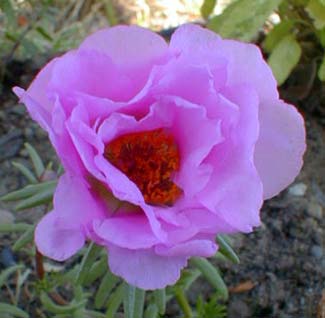
Moss Rose
Mixed Doubles
"And the soft desire of maiden's e'en
In that mild face could never be seen.
Her seymar was the lily flower,
And her cheek the moss-rose in the shower."
-James Hogg
(1770-1835)
(1770-1835)
"This is an evergreen perennial," said the sales lady at Ace Hardware, where I'd dropped by for some hose repair bits.
"Is that so? I thought they were annuals."
"Oh no, I planted some last year, & they're evergreen perennials all right."
Well, maybe she didn't mean to lie. Perhaps she mixed them up with something on the order of Oregon Stonecrop or Trailing Iceplant, since Moss Rose's long fat leaves have the same visual impact as so many rockery succulents. I can't think of another trailing succulent that isn't a perennial, so I'm willing to believe it's an easy mistake to have made.
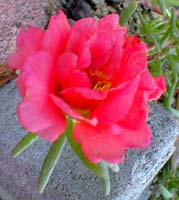 I don't know a great deal about annuals because I prefer plants that have lasting power. I just about ninety-percent avoid annuals, & skip over reading the bits about annuals in magazines & books.
I don't know a great deal about annuals because I prefer plants that have lasting power. I just about ninety-percent avoid annuals, & skip over reading the bits about annuals in magazines & books.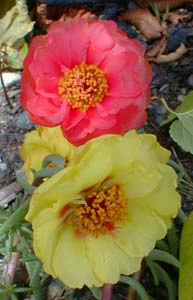 So there I was scratching my head all befuddled, but willing to believe I'd misremembered, & the sales lady had it right.
So there I was scratching my head all befuddled, but willing to believe I'd misremembered, & the sales lady had it right.Therefore I bought a passle of these allegedly evergreen perennial double moss roses, only to discover within the hour, upon opening a reference book at home, that I'd bought a mess of annuals.
Determined to get the most from my mistake, I planted them amidst sages & other sun-loving herbs, expecting them to fill up the in-between spaces for the summer at least.
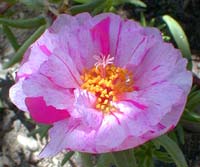 In warm climates moss roses can self-seed, but this isn't likely to occur here on Puget Sound, so these were destined to be a transient presence in our garden.
In warm climates moss roses can self-seed, but this isn't likely to occur here on Puget Sound, so these were destined to be a transient presence in our garden.Native to Uruguay, Brazil, & northern Argentina, Portulaca grandiflora (synonymous with P. pilosa ssp. grandiflora), it was first described in 1828 by American botanist W. J. Hooker after his journey to the Rio Desaguardero in South America.
Right from the start, Hooker noticed varied colors growing in proximity, having seen bright orange flowers mixed amidst purple. Their proclivity for extremes of color was first studied in Japan in the 1920s, & the species has ever since proved itself particularly fascinating to researchers for its chemical & genetic qualities.
Being from dry plains regions, it likes sandy well-draining soil in full sun. On overcast days the flowers may not open.
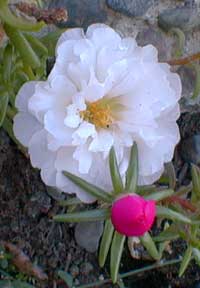 Though called a "moss" rose, & sometimes the other way around as Rose Moss, the succlent leaves are not actually very mossy. Because it wants full bright sun it is also known as the Sun Flower, or because of its weedy cousin Purslane (P. oleracea) it is occasionally called Large-flowering Purslane.
Though called a "moss" rose, & sometimes the other way around as Rose Moss, the succlent leaves are not actually very mossy. Because it wants full bright sun it is also known as the Sun Flower, or because of its weedy cousin Purslane (P. oleracea) it is occasionally called Large-flowering Purslane.It requires no attention to spread & bloom vigorously all summer, & not inconceivably from May all the way to October.
They even do well in windowsill planters, & will trail downward out of hanging baskets.
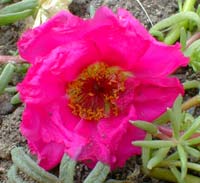 It creeps about on the ground, three to eight inches high, trailing to around a foot wide.
It creeps about on the ground, three to eight inches high, trailing to around a foot wide.For all their drought hardiness, they bloom best with a weekly watering. Sometimes the flowers get so thick the leaves nearly disappear.
"Double" moss roses produce flowers ranging from one inch to two inches, in many of the brightest possible colors. Some of them really do look like rose blossoms though set amidst succulent leaves instead of amidst thorny rose stems.